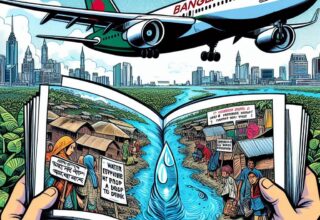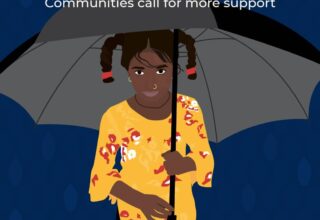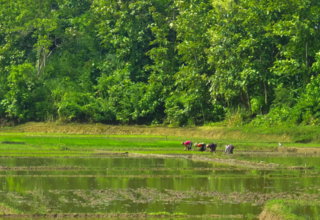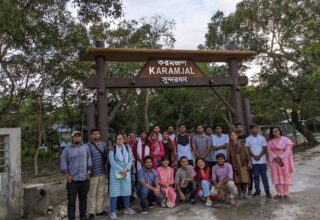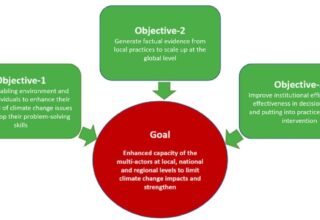(This article was originally published here)
Climate change is a “sexy” topic in contemporary global discourses. In Bangladesh, recurrent natural disasters over the past few decades stand witness to the manifestations of climate change. Scientific research, peer-reviewed literature, and social studies posit the country to be one of the most vulnerable in the world.
As an environmentalist having worked in Bangladesh for over a decade, the lion’s share of my work has been on adaptation to climate change, especially in the rural, remote, and ecologically fragile areas of the country.
My research entails extensive travel to field sites, and has taken me places and introduced me to the many faces of climate change, and taught me the most important lesson in life: Bangladeshi people are fighters — they are heroes, and can adapt to almost any form of adversity.
I have lived my entire life in Bangladesh and in the urban settings of Dhaka, and I have seen changes in climate: Just over the past 30 years, the seasons have altered dramatically. In school, we learnt that Bangladesh was a “shoro reetur desh,” which roughly translates to the country having six seasons.
But what we experience now is a predominant summer, followed by monsoon, or the rainy season, and then, a short spell of winter, and a brief period of spring. There are certain anomalies which have crept up, for instance, in the rainfall patterns and untimely rain in the winter months, which don’t harm us city-dwellers much, but damage the robi (seasonal) crops in the rest of the country.
The effects of climate change: Farmers incurring regular losses because of multiple hazards such as erratic rainfall, flash floods in the north-east, and drought-like conditions in the north-west, salinity intrusion in coastal areas, land loss due to river erosion — just to name a few of the major climatic adversities.
At university, in a course on disaster management, our professor taught us about the “return period” of disasters, and how there are considerable gaps between the occurrence of natural calamities.
In 1998, just after 10 years of the devastating flood of 1988 which inundated more than three-quarters of Bangladesh, another major flood paralysed the country’s economy. The capital city was flooded as well — our classes got suspended as commuting became impossible.
Just six years later, there was another flood in 2004. At that time, I was working at an inter-governmental organisation and even our office premises in the Gulshan area of south Dhaka was not spared. The nasty flood-waters rose from the Gulshan-Banani-Baridhara Lake and mixed with the sludge and solid waste. One of our support staff members lived in the shanty squats of Badda, and had to wade through polluted water every day to get to work. His home itself was under knee-deep water, and his legs were full of infections.
In 2007, super-cyclone Sidr hit the coastal areas of Bangladesh, but the impact was so huge that the entire country experienced a power outage for the next few days. There was death and misery, and massive damage — countless coastal communities were wiped out in a matter of hours.
Just a few weeks earlier, I had visited the coastal chars of Bangladesh and, frustratingly, I was unable to reach the high-school students I worked with, as all communication networks were disrupted. The school girls and boys had to walk miles through waist-deep, water-logged roads and embankments after the cyclone, with extra clothes in a plastic bag, so that they could change into them when they reached school and attend classes.
For some commissioned research work, I visited a coastal village in Dakop, Khulna in 2013, which was struck by cyclone Sidr and, two years later in 2009, was hit by another highly intense cyclone named Aila. Almost three-quarters of the Dakop union (smallest administrative unit) was permanently inundated by salt-water, and hundreds of displaced people were literally living on the edge — on precarious crumbling beri bundh (earthen embankment) breached by the tidal surges — even though four years had lapsed since the disastrous event.
Climate change took on the face of the women I was having a discussion with — sexually harassed even when they go out to defecate and urinate after dark, usually perched on the edge of a country boat.
The reason I have written about disaster events chronologically is just to illustrate the point that what I learnt in school and at university is no longer applicable. We are experiencing disasters at a greater frequency and of an even greater magnitude than ever before, not to mention an unpredictable weather.
Who are the worst affected victims of climate change in Bangladesh? Intuitively, it is the impoverished, rural people, dependent on natural resources and inhabiting disaster-prone areas of the country. These people represent the true face of climate change, people living on the edge and adapting to changing climatic conditions within their limited means.
For me, they personify the issues of climate change and demonstrate the concepts of resilience and adaptation. The lives and livelihoods and chronicles of the resilient people of Bangladesh never cease to amaze and inspire me. As a Bangladeshi, I feel a moral obligation to serve them, through my knowledge, understanding, and experiences.
Written by: Remeen Firoz

